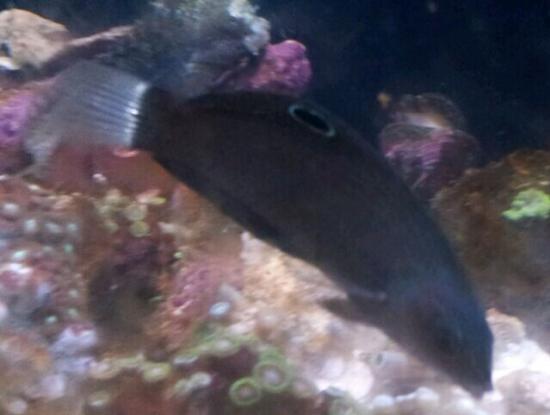
MadScientist
SRC Member-
Posts
1,859 -
Joined
-
Last visited
-
Days Won
6
Content Type
Profiles
Forums
Gallery
Everything posted by MadScientist
-
Carbon doesn't really release adsorbed materials back. When you start to see algae growth or a little yellowing of water, you need to change the carbon immediately. Testing of organics may help, I believe it's not very useful though. I used to add a fixed amount of potassium permagnate onto stagnant test water (done out of tank) and observe how fast it turns dirty brown, the faster it is, the sooner you need to change your carbon. You can also do test directly on the carbon with methylene blue or iodine adsorption time.Salifert sells activated carbon test kit. Not much information on it.
-
Hold up button until the digits blinks continuously. Release the up button. Press up/down button to set to your desired temperature. Wait till the blinking stops. Done
-
Mega Powerful Nitrate and Phosphate Remover - DIY!
MadScientist replied to SantaMonica's topic in General Reefkeeping_
Water too good -
Finding Nemo 3D in Singapore End Oct to Nov 2012
MadScientist replied to Gouldian's topic in General Reefkeeping_
Gex used to showcase saltwater goldfish before too. Sw and fw are merging?- 12 replies
-
- Movie
- Finding Nemo 3D
-
(and 1 more)
Tagged with:
-
which Phosphate Remover is less messy to handle
MadScientist replied to finind's topic in Product Reviews
I am also using phosguard and rowaphos. Added in matrix carbon and renew too. Phosphate undetectable, as usual. Diatoms and some cyano show otherwise. Phosphate readings may not be very useful as organisms/abiotic binding are taking them, trapping and releasing especially at very low levels. Observations of the ls response may be a better choice -
Mind pming price? Thanks. Interesting led. Also from iwarna?
-
Black Diamond is not bad, where did you get it over here? As long as the container is air tight, there's no expiry. Carbon do adsorb contaminants from the air as well, it expires when it reaches full capacity
-
<p> Chemipure is not 100% carbon. Decent brands include rowacarbon, tlf hydrocarbon, rox and seachem matrix carbon
-
That would depends on your bioload. For me, green tea colour and darker would be ideal
-
that applies to all tanks, not just nano.
-
crystal pro ro/di vs ZeRO EX 4- RO/DI 4 Stages
MadScientist replied to inwear's topic in Product Reviews
Isn't ro supposed to be first stage? -
FOC 2 x Green Monti...provided that
MadScientist replied to dnsfpl's topic in Sell off/Pasar Malam Shop
Bro, i can test your water, but can don't take the monti? -
They believe that their nsw is actually bacterial cultures and their lr are literally jumping around From being too alive
-
Where did you get the holder?
-
76
-
The phosphate is particulate-d out. Skimmers have limited capacity in removing of such particulates. It is highly recommended to have a fine mechanical filtration when using such products.
-
which Phosphate Remover is less messy to handle
MadScientist replied to finind's topic in Product Reviews
Where did you get your Lanthnum Chloride from? -
What's the point of liquid iron based remover when there's no way to export it?
-
Rowaphos is ferric (iron) hydroxide. Phosguard is aluminium oxide. Liquid phosphate remover is Lanthanum Chloride. Rowaphos is more commonly used due to the non-leeching of aluminium, leeching of iron is usually harmless. ferric oxide has the lowest rate of removal of phosphate and silicate, it has a longer service lifespan as it takes time for it to reach its capacity due to the slower rate of removal of phosphate. Phosguard has a higher rate of phosphate removal, hence the need to follow instructions strictly. It has a shorter service lifespan. It may leech some aluminium. Liquid phosphate remover has been long used by aquaculture/public aquarium, water treatment and swimming pool industry to remove phosphate. It has the quickest rate of phosphate removal. It has the shortest service lifespan (almost immediate to a few seconds, depending on circulation rate). It is very cost effective for large volume. A mechanical filtration is required (<10 micron mesh) to remove the particulate from the water. Some corals/ fishes are sensitive to the particulate. It is used on very large volumes of water due to its cost effectiveness. For small water volumes, overdose is easily a real risk. There is no scientific evidence on the positive/negative side effects of overdose of Lanthanum Chloride on corals and fishes. Anecdotal evidence suggests that corals and fishes may be affected from the overdose. Overdose will result in extreme rates of removal of phosphate to near non-existing levels. This can result in stress to the corals. Use of liquid phosphate removal is strongly encouraged to be accompanied by phosphate monitoring with a highly sensitive test method as it can easily and rapidly bring down phosphate levels to extremely low levels. Most users would overdose liquid phosphate remover easily due to its low costs, rapid rate of action and the lack of access to high resolution/sensitivity test methods.
-
new shop in town? How far will you drive????
MadScientist replied to theozman670's topic in Product Reviews
Hard to get a cab to go in to fetch us out -
which Phosphate Remover is less messy to handle
MadScientist replied to finind's topic in Product Reviews
Aluminium based are very solid if you don't care about aluminium leeching and the rapid rate of adsorption. Liquid po4 remover has an even faster rate of action though. I am using both rowaphos and phosguard. Rowaphos in teabag and fine mesh bag -
Finding Nemo 3D in Singapore End Oct to Nov 2012
MadScientist replied to Gouldian's topic in General Reefkeeping_
Hopefully, AVA steps in and be stern with the lfs- 12 replies
-
- Movie
- Finding Nemo 3D
-
(and 1 more)
Tagged with:
-
Thanks
-
any full tank shot?


